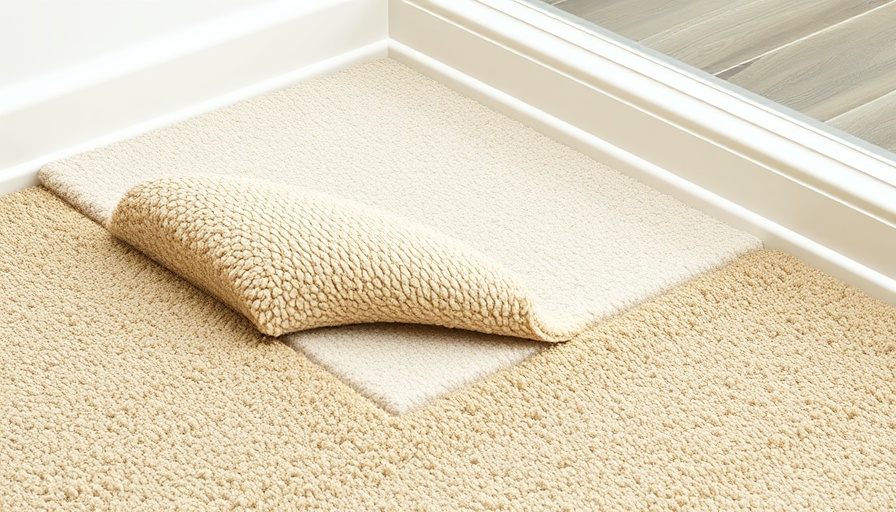
Understanding Mold and Its Implications for Your Home
Mold is not just an unsightly blemish on your carpet; it poses serious health risks, particularly to children, the elderly, and those with pre-existing conditions. As a homeowner, it's essential to understand how mold thrives and spreads. Mold spores, which are microscopic and easily airborne, can grow in as little as 24 to 48 hours after water exposure. This rapid growth underlines the importance of timely intervention. The connection between hydro conditions and mold proliferation emphasizes the necessity of a proactive approach in your home maintenance routines.
Gathering Your Tools: The First Step to Success
Before you start the mold removal process, collect all the necessary tools. At a minimum, you'll need:
- A protective mask and gloves to ensure your safety while handling potentially harmful mold.
- A stiff-bristled brush for scrubbing the affected area.
- A vacuum cleaner with a HEPA filter to trap mold spores.
- Baking soda, a natural deodorizer and mild abrasive.
- White vinegar, a powerful disinfectant.
By having these items on hand, you'll be well-prepared to tackle even the most stubborn mold.
The Seven Steps: Safely Removing Mold from Your Carpet
Now that you're equipped, let’s dive into the seven straightforward steps to rid your carpet of mold:
- Ventilate the Area: Open curtains and windows to enhance airflow and help the carpet dry quicker.
- Inspect the Carpet: Identify all affected areas by checking not just the surface, but also the underside of the carpet.
- Scrub the Mold: Using your brush, scrub away the visible mold. Follow this with a thorough vacuum to remove debris.
- Apply Baking Soda: Generously sprinkle baking soda on the affected area. Let it sit overnight to absorb moisture and odors, then vacuum it up.
- Vinegar Application: Fill a spray bottle with white vinegar and apply it directly onto the mold. After a few minutes, scrub again with the brush.
- Blotting: Use a damp towel to blot the area, removing residual mold and vinegar.
- Dry the Carpet: Allow the carpet to dry completely to prevent future mold growth.
These steps not only clear mold but can contribute to a healthier home environment.
Identifying Mold: Visible Signs to Watch For
Understanding how to identify mold can save you time, hassle, and potential health risks. Look for:
- Visible Growth: Mold can often be spotted in dark patches on carpet fibers.
- Color Variation: Mildew presents as yellow, gray, or white, while mold can be green, black, or even blue.
- Water Damage: Stains or watermarks often indicate hidden mold growth beneath the surface.
- Foul Odors: A musty smell lingering in the air can indicate mold, even before it’s visible.
Prompt identification helps mitigate the spread of mold, ensuring your home remains a sanctuary for your family.
The Urgency of Action: Why Removing Mold Matters
Ignoring mold in your carpet can lead to significant health risks, including respiratory issues and allergies. Mold affects air quality, potentially causing lung diseases and other serious health problems. Moreover, mold can spread rapidly, resulting in more extensive damage to your home and requiring expensive professional intervention. Therefore, if you notice mold growth, particularly smaller areas less than 10 square feet, address it immediately using the methods above. For larger infestations, don’t hesitate to seek professional help.
Preventing Future Mold Growth: Proactive Measures
Once you've effectively removed mold from your carpet, it’s vital to implement strategies to prevent its return:
- Control Humidity: Use dehumidifiers in areas prone to moisture, such as basements.
- Regular Cleaning: Maintain a routine deep cleaning schedule, focusing on high-risk areas in your home with carpets.
- Fix Leaks Promptly: Address any plumbing issues immediately to eliminate sources of moisture.
By adopting these preventive measures, you maximize the chances of keeping your home mold-free.
Mold removal doesn’t have to be a daunting task. With these practical steps and a little effort, you can regain control of your space and ensure a healthier environment for your family. Remember, the key is to act fast, be thorough in your cleaning, and prioritize preventing mold from returning. Ready to reclaim your carpet and safeguard your home? Start your mold removal journey today!
 Add Row
Add Row  Add
Add 




Write A Comment